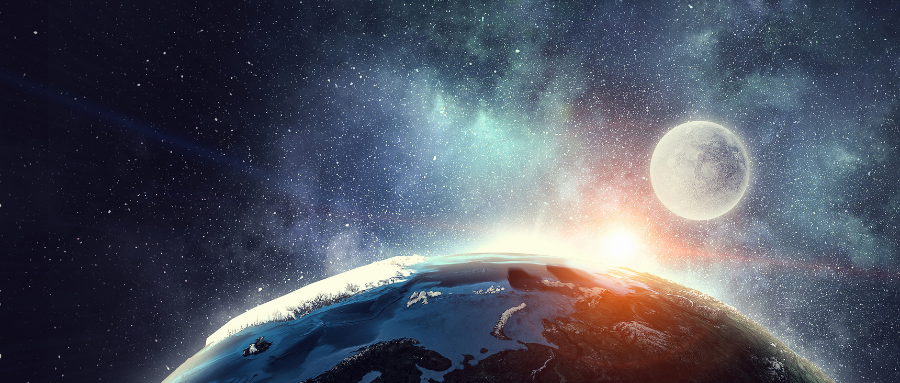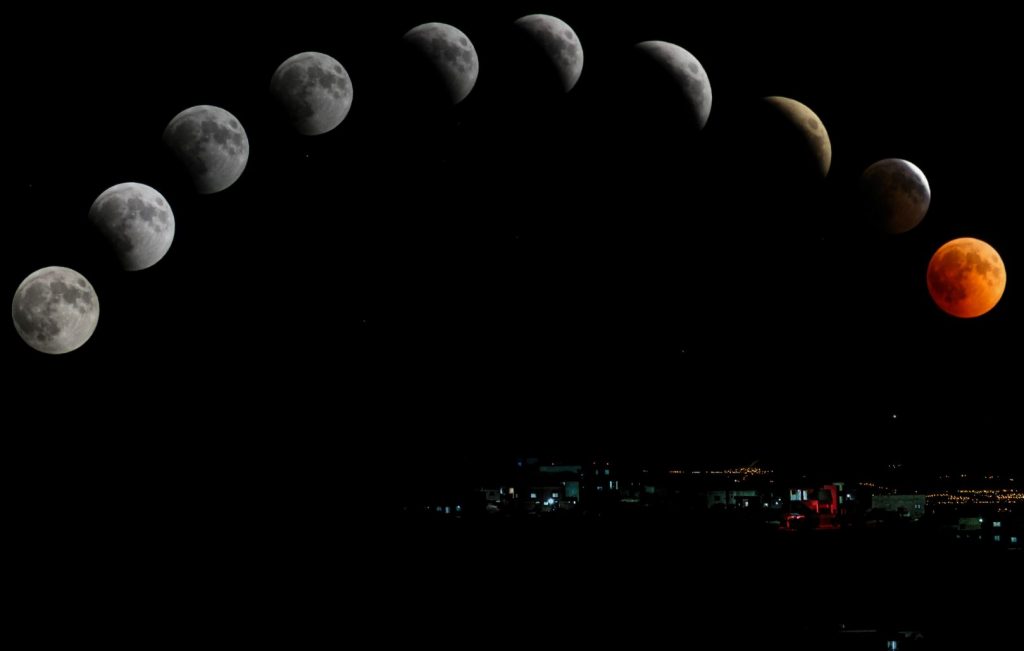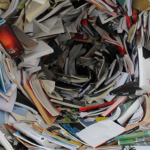The Chinese lunar probe named Chang’e 4 successfully landed on the far side of the Moon at 2:30am GMT Jan 03 2019. It is the very first time in history that humans have explored the Moon’s so-called “dark” side, which, until now, it has remained something of a mystery. Though it is not really dark– the Sun shines there, too– the far side the Moon has been called “dark” because it never faces the Earth due to what astronomers call “ tidal locking.” The Moon rotates on its own axis at exactly the same rate that it orbits around the Earth. It takes the Moon 27.3 days to rotate once on its own axis, and it also takes 27.3 days for the Moon to make one orbit around the Earth. The result of tidal locking is that the same side of the Moon faces the Earth at all times. This situation creates a major challenge for space explorers: the far side of the Moon is shielded from radio transmissions from Earth, thus preventing any direct communication– this is largely what prevented previous exploration of the Moon’s far side. China’s Chang’e program developed a plan for indirect radio contact by relaying signals through a Chang’e satellite, called the “Magpie Bridge,” located far beyond the Moon’s orbit to allow the Chang’e lander to communicate with Mission Control, back on Earth.
Chang’e is the Chinese Moon Goddess. In the legend dated circa 2400 BCE, she stole the immortality pill and rose up to the moon trapped as a fairy goddess. Four thousand years later, China developed advanced technology to unveil the myths of her “lunar palace” that had remained unexplored by mankind.
Professor Farzad Mahootian is a Clinical Associate Professor at New York University where he has been for eight years, where he teaches courses Liberal Studies courses in interdisciplinary humanities and sciences. His research has been published in the Boston Studies in Philosophy of Science, and Cambridge University Press, among others. Dr. Mahootian has been awarded grants from the Arizona State University Institute of Humanities Research, Templeton Foundation, National Science Foundation Grant, and NASA Learning Technologies Program Cooperative Agreement. He has developed and evaluated programs for NASA with the support of Raytheon Technical Services Company. Through his experiences, Professor Mahootian has conferred with scientists, teachers, and students alike and is proud to admit he has learned a lot from all parties; during the internet boom of the 1990s, he helped to provide students online access to a database of satellite data of the Earth and other planets, so they could acquire information previously used only within the scientific and scholarly community.
Student Questions Answered by Professor Mahootian:
Laura from the U.S. was selected and participated in Pioneer Academic’s astronomy field in spring 2018; her research paper is entitled “Blazar Jets Kinematics and Related Topics.”
The dark side of the moon has more craters than the side that we see. Why?
The short answer is that over the course of its history, tidal forces tinned the surface of the near-side of the Moon, resulting in more numerous lava flowing more readily than on the far side. The flow-covered areas called “Maria,” Latin for “Seas. A large number of older craters on the near side of the Moon have been covered and erased by volcanoes and lava flows. So the next question is, “why were there more volcanoes on the near side?” The answer has to do with the effect of the Earth gravity on the near side: just as the moon tugs on Earth’s oceans to produce high and low tides easily observable at ocean beaches, it also attracts the solid Earth, but the latter is not easily observed. Now, the same force that pulls at the Earth’s surface also pulls the Moon’s (the force of gravity felt by Earth and Moon is the same). As soon as the Moon was formed in orbit around Earth, its rotation on its own axis gradually became locked into to its revolution around the Earth. This gradual adjustment is called “tidal resonance” and it locked the Moon into the situation we observe today: only one side of the Moon ever faces Earth because the Moon’s rotation on its own axis takes exactly the same amount of time as its revolution around the Earth. Over time, the crust of Moon’s near side becomes thinner than the crust on the far side because the near side always feels the Earth’s gravity more strongly than does its far side. Lava flows came to the surface of the ancient Moon more readily on the near side– because of its relative thinness– thus covering craters more often on the near side. This process went on for as long as it took for the Moon’s core to cool off and end all of its volcanic activity.
Laura from the U.S.
Did the asteroids that hit the Moon hit Earth when life first appeared? Did those asteroids bring the necessities for life?
We have evidence from other missions that various organic chemicals, some of which are necessary for the maintenance of life on Earth, are synthesized on other bodies in space. So it’s very possible that asteroids and comets, which routinely carry these molecules in the water ice (which is both on and under their surface) introduced the necessities of life when they crashed into Earth. Water ice exists all through the known universe: even the planet Mercury has ice on its surface, despite its very high temperature and extreme closeness to the Sun, since some areas of the north and south poles of Mercury and other planets are permanently in shadow. Because of the abundance of water in the universe, any body that collides with the Moon or the Earth, will contain ice and that itself is likely to contain organic chemicals.
But the key question is exactly what molecules are necessary not just for maintaining life, but for actually starting life? In the field of astrobiology, we look for as many molecules as possible which could possibly aid in the rising of life. Generally, these include molecules containing nitrogen, carbon, and oxygen. Essentially, every celestial body that is able to have ice that hasn’t melted yet may have captured some of those organic chemicals. It’s a very interesting question and unless we have samples from the moons of Mars and Jupiter, it’s not really possible to answer.
Julie (10 year old space fan) from the U.S. Pioneer community:
Since the Moon is rotating at the same time it orbits the Earth, how was the probe landed on the side of the Moon that does not face the Earth?
The beautiful physics of bodies moving in space is called mechanics, and in the case of celestial bodies, it is called celestial mechanics. For every space flight, scientists must calculate how long it takes to get to a celestial body while that body is not only moving through space, but also spinning on its own axis. Once it gets near its destination, the spacecraft must change and stabilize and movement to match the orbit of the planet it is trying to land on. In order to touch down on a planet or moon, you must first stay in its orbit. Depending on the angle and speed with which you enter a moon’s neighborhood, your may have to orbit the moon several times.
And this is where Magpie Bridge comes into play: it can communicate in near-real time with the lander (it takes 1.3 seconds for a signal to go between Magpie Bridge and Mission Control), to see if the lander is where the Chinese space agency ground control thinks it should be at any given point in time, and then relay this information back to ground control. If the spacecraft is even a little off course in its orbit that could translate into being way off course for its landing site. The Magpie Bridge has direct communication with the lander and with mission control, and has the capacity to adjust its position, from moment to moment, from orbit to soft landing. With Chang’e 4, the information was sent back and forth via the Magpie relay and so there was a bit more of a lag in exchanging information but an absolute absence visual contact. So, with input from the engineers at mission control, the autonomous lander had to make its own adjustments, in hopes that their calculations matched the lander’s situation. This is potentially risky because the Moon’s gravity is not uniform all across its surface variations in the solar wind could also change the lander’s orbit, so you are taking a risk whenever you make calculations not knowing what variations the spacecraft might encounter. The unexpected crash landing of an Apollo mission sub-satellite, PFS-2, led to the discovery of major variations in lunar gravity across its surface. So you are taking a risk whenever you make calculations not knowing what variations the spacecraft might encounter. You must hope you have good luck, and trust in the spacecraft’s autopilot because you can’t know if it will crash or land. The Magpie Bridge reduced the risk tremendously by continuously transmitting the lander’s position back to mission control. For those interested in learning more, the field which studies this question of simultaneous movement of moons, planets and spacecraft, look up “celestial mechanics.”
Why did China pick the egg of the silkworm to test on the moon? Would it be a good idea to test cockroach eggs, too?
I think cockroach eggs would have been great as well. Cockroaches have existed on planet Earth for 300 million years. While earthworms and other members of the worm family, including silk worms, began to appear about 600 million years ago, silkworms as we know them, were domesticated and selectively bred not much more than 5000 years ago. Nevertheless, it certainly seems to be the case that cockroaches are more hardy than silkworms. This means that if silkworms can survive this experiment, then a broad array of organisms could also survive the Moon’s gravitational environment. Also, and perhaps more importantly, the choice of silkworm rather than cockroach is an important symbolic gesture intended to commemorate China’s contribution of silk to the world.
Albert from Beijing, China submitted his questions on the Pioneer community:
Since the far side of the moon always faces away from the earth, is it possible to build architectures that are only known to the builders?
Though I’m not positive about what it means to be “only known to the builders,” it seems to express a concern about the potential of building a station or other structures that are hidden from view. But in fact, nothing would be hidden from everyone permanently– there have been previous lunar mapping missions and NASA’s Lunar Reconnaissance Orbiter continues to map both sides of the Moon to this day. So it would be impossible to keep something hidden forever.
Iris from Shanghai, China submitted her questions on the Pioneer community:
What is expected to be the differences (geographic/environmental) between the dark side and the side that we can see, and what are the anticipated practical meanings of this exploration?
Questions about the Moon’s environment must consider geological and geochemical factors, as well as geographical ones. While there are composition maps of both sides of the moon, thanks to previous Lunar mapping missions (see the end of this feature for more links), the environment of the far side has never been sampled from the surface, so there is much to learn about the differences between the near and far side environments. The most dramatic geological difference is the absence of Maria, therefore more craters, on the far side. The Chang’e landing site, the Von Karman crater, is located in the gigantic Aitken Basin– the largest known impact crater in the whole solar system. This site was chosen because the massive impact that created the basin has exposed the Moon’s deep crust, and likely its mantle as well. So, thanks the Chang’e 4, we may learn something really new about the Moon’s composition. Samples collected here will tell us about the early history of the Moon, and possibly give us a definitive understanding of its origin– this is incredibly exciting!
Albert from Beijing:
Is it possible to build a launch center on the other side of the moon and use it to somehow reduce the distances needed to travel for probes on future missions? Or would that distance be small enough to be trivial?
The distance would not be significantly different in comparison to the distance it needs to travel from the Moon to destinations beyond. So whether a spacecraft is launched from the near or far side wouldn’t make a significant difference. It’s easier to have launch and maintain contact from the near side. NASA and other space programs plan to build stations on the near side. The amount of fuel needed to achieve lift-off from the Moon is a lot less than launching from Earth. So, after lunar space stations (which would not be a trivial cost) are built, launches from the Moon would be cost effective in the sense that spacecraft could go a lot further with far less fuel. This would be a great benefit.
Tommy from Canada studied physics through Pioneer Academics in the summer 2018 semester; his research paper is entitled, “Sulfur K-edge micro-X-ray Absorption Near-Edge Spectroscopy (XANES) using synchrotron radiation.”
How will this [exploration] of the other side of the moon benefit potential future lunar missions? Should we establish a lunar research base in the future? If so, what are some advantages and disadvantages of conducting such mission? In what ways can the Chang’e 4 mission benefit future Mars exploration missions?
The most immediate advantage is for telescopes that would be placed on the far side of the Moon, for there will be virtually no interference from radio signals from the Earth. Furthermore, while we have established that there’s a difference between the near and far sides of the Moon (see the previous questions on this), we can verify our theories about the difference– its composition and origin– only by being there to actually collect samples, run experiments and take measurements. Without physically going to specific sites like the one that Chang’e 4 has selected, we would never have a reliable answer to your questions. Also, as indicated in an answer to a previous question about Lunar stations, the space programs of several countries agree that the Moon should be viewed as stepping stone to other celestial bodies, with Mars as the next stop. Aside from the advantage gained by Moon-based telescope, there are cost-saving advantages: we can go farther with less fuel by launching new missions from the Moon rather than from Earth.
Tommy from Canada:
Since China is slowly catching up with the United States in the arena of space exploration, do you think the success of Chang’e 4 can spark another space race between the different countries on Earth?
I think that Chang’e may direct more of NASA’s attention on the Moon in the future. There has been a growing interest in the “back to the Moon” movement of the past few decades; NASA may indeed feel some competition from the Chang’e program, but there is room for collaboration as well. Why has NASA never sent a lander to the far side? This is a great question to ask someone that has worked on NASA’s lunar missions. I worked with various NASA education programs for about 10 years and during part of that time, I worked directly with NASA Headquarters. I learned that whenever NASA makes decision about selecting any mission for launch, there are always a lot of competing missions, each of which is interesting and important. So there is always the difficult choice of selecting one really good mission over another really good mission. Scientist and program managers have to weigh how much money should be invested and consider the scientific, technical, social, and political gains in each case.
I think the communication challenge was a factor, and certainly one that increases the cost of a mission to the far side, but it was probably not the single main issue. It’s usually a very complicated process, but looking back at the long hiatus between NASA lunar missions from the 1970s to the 1990s, it seems that someone presented the argument that “we know enough about the Moon,” and this effectively reduced interest in and funding for any Moon missions…until recently. In August 2018, NASA announced a new “sustainable campaign to return to the Moon, and on to Mars,” and marked the beginning of “America’s new Moon to Mars exploration approach” in December 2018, just ten days after Chang’e 4 was launched. Finally, here is a recent story about the potential for US-China space cooperation and collaboration, in connection with the Chang’e program.
Tommy from Canada:
If Chang’e 4 were to discover large amount of mineral deposits and intriguing rock composition, do you think it would be a good idea to start excavating the surface of the moon and conduct mining operations?
Here are a number of beautiful surface maps of the entire Moon (from data collected by NASA’s Clementine, Lunar Prospector and other missions), one of which is a chemical composition map that offers a lot of clues about what might lie below the surface. There have been studies about the economic feasibility of mining the moon for mineral, even for the water from Lunar ice. Mining requires heavy equipment and lots of energy. While people have proposed extracting hydrogen and oxygen from Lunar water for the energy needs, the cost of shipping heavy mining equipment to the Moon is still quite high. Here’s a Business Insider magazine article that discusses price-per-pound cost of lifting things from Earth into orbit … and these prices are just for transporting things to the International Space Station, which is actually in a low-Earth orbit. It would cost more to get things safely to the Moon!
Pioneer Editor from Space:
What additional resources can I turn to?
For future reference: The best space science pictures are on NASA photojournal site: https://photojournal.jpl.nasa.gov
See the NASA Moon Art gallery, and also the Moon overview page, showing landing sites and a sampling of different kinds of maps.
Here is an informative article on Chang-e 4’s mini-biosphere, from the International Business Times. News flash: here is an update about the mini-biosphere experiment: one of the seeds has germinated!
The BBC website had some very good details too, but they erroneously listed fruit fly eggs rather than silkworm eggs! Surprisingly, nearly two weeks have passed and they have not corrected that error since its original publication on Jan 3. It seems that they have missed the entire symbolic dimension of the Chinese-ness of the mission!
The South China Morning Post published a story about how China’s Moon rover may be looking for a Helium isotope that could be used as alternative rocket fuel, noting that,
“The primary element on the moon is helium-3, which for now is too expensive to haul back to Earth. In theory, the non-radioactive isotope could be used as fuel for the next generations of spacecraft to explore deeper into space.” This is misleading because helium-3 is not a “primary” element on the Moon– at 50 parts per billion maximum, it is hardly that. Perhaps the author meant that helium-3 is a “primary target for extraction.” Here is an article from the European Space Agency with some more detail on the potential and cost of Lunar helium-3.



 Doing research is commonplace.
Doing research is commonplace.


